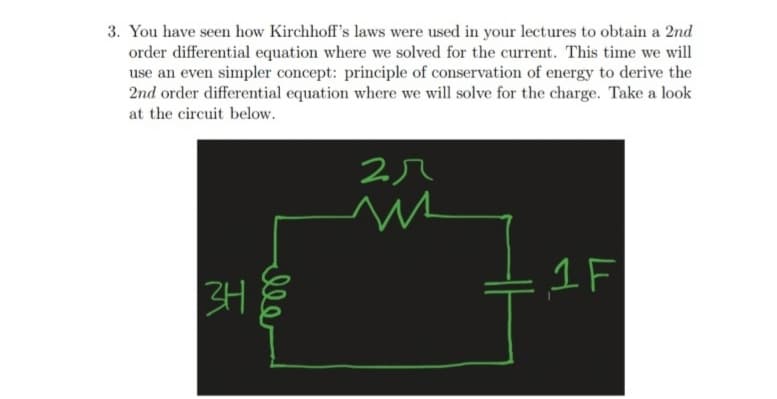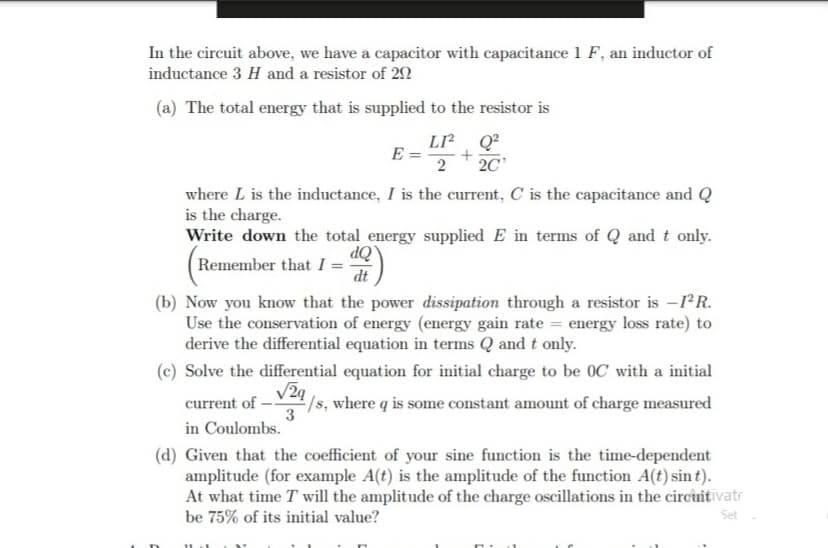In the circuit above, we have a capacitor with capacitance 1 F, an inductor of inductance 3 H and a resistor of 22 (a) The total energy that is supplied to the resistor is LI Q? E = + 2 20 where L is the inductance, I is the current, C is the capacitance and Q is the charge. Write down the total energy supplied E in terms of Q and t only. Remember that I = ÒP dt (b) Now you know that the power dissipation through a resistor is -rR. Use the conservation of energy (energy gain rate = energy loss rate) to derive the differential equation in terms Q and t only. (c) Solve the differential equation for initial charge to be 0C with a initial V29 current of - 3 /s, where q is some constant amount of charge measured in Coulombs. (d) Given that the coefficient of your sine function is the time-dependent amplitude (for example A(t) is the amplitude of the function A(t) sin t). At what time T will the amplitude of the charge oscillations in the circiuitivatr be 75% of its initial value? Set
In the circuit above, we have a capacitor with capacitance 1 F, an inductor of inductance 3 H and a resistor of 22 (a) The total energy that is supplied to the resistor is LI Q? E = + 2 20 where L is the inductance, I is the current, C is the capacitance and Q is the charge. Write down the total energy supplied E in terms of Q and t only. Remember that I = ÒP dt (b) Now you know that the power dissipation through a resistor is -rR. Use the conservation of energy (energy gain rate = energy loss rate) to derive the differential equation in terms Q and t only. (c) Solve the differential equation for initial charge to be 0C with a initial V29 current of - 3 /s, where q is some constant amount of charge measured in Coulombs. (d) Given that the coefficient of your sine function is the time-dependent amplitude (for example A(t) is the amplitude of the function A(t) sin t). At what time T will the amplitude of the charge oscillations in the circiuitivatr be 75% of its initial value? Set
Advanced Engineering Mathematics
10th Edition
ISBN:9780470458365
Author:Erwin Kreyszig
Publisher:Erwin Kreyszig
Chapter2: Second-order Linear Odes
Section: Chapter Questions
Problem 1RQ
Related questions
Question
Need help, Dont change subj, its a math problem

Transcribed Image Text:3. You have seen how Kirchhoff's laws were used in your lectures to obtain a 2nd
order differential equation where we solved for the current. This time we will
use an even simpler concept: principle of conservation of energy to derive the
2nd order differential equation where we will solve for the charge. Take a look
at the circuit below.
1F
ll

Transcribed Image Text:In the circuit above, we have a capacitor with capacitance 1 F, an inductor of
inductance 3 H and a resistor of 22
(a) The total energy that is supplied to the resistor is
LI Q?
E =
2
2C
where L is the inductance, I is the current, C is the capacitance and Q
is the charge.
Write down the total energy supplied E in terms of Q and t only.
ÒP
Remember that I = -
dt
(b) Now you know that the power dissipation through a resistor is -rR.
Use the conservation of energy (energy gain rate = energy loss rate) to
derive the differential equation in terms Q and t only.
(c) Solve the differential equation for initial charge to be 0C with a initial
/s, where q is some constant amount of charge measured
3
current of
in Coulombs.
(d) Given that the coefficient of your sine function is the time-dependent
amplitude (for example A(t) is the amplitude of the function A(t) sin t).
At what time T will the amplitude of the charge oscillations in the circnitivatr
be 75% of its initial value?
Set
Expert Solution
This question has been solved!
Explore an expertly crafted, step-by-step solution for a thorough understanding of key concepts.
Step by step
Solved in 3 steps with 3 images

Knowledge Booster
Learn more about
Need a deep-dive on the concept behind this application? Look no further. Learn more about this topic, advanced-math and related others by exploring similar questions and additional content below.Recommended textbooks for you

Advanced Engineering Mathematics
Advanced Math
ISBN:
9780470458365
Author:
Erwin Kreyszig
Publisher:
Wiley, John & Sons, Incorporated

Numerical Methods for Engineers
Advanced Math
ISBN:
9780073397924
Author:
Steven C. Chapra Dr., Raymond P. Canale
Publisher:
McGraw-Hill Education

Introductory Mathematics for Engineering Applicat…
Advanced Math
ISBN:
9781118141809
Author:
Nathan Klingbeil
Publisher:
WILEY

Advanced Engineering Mathematics
Advanced Math
ISBN:
9780470458365
Author:
Erwin Kreyszig
Publisher:
Wiley, John & Sons, Incorporated

Numerical Methods for Engineers
Advanced Math
ISBN:
9780073397924
Author:
Steven C. Chapra Dr., Raymond P. Canale
Publisher:
McGraw-Hill Education

Introductory Mathematics for Engineering Applicat…
Advanced Math
ISBN:
9781118141809
Author:
Nathan Klingbeil
Publisher:
WILEY

Mathematics For Machine Technology
Advanced Math
ISBN:
9781337798310
Author:
Peterson, John.
Publisher:
Cengage Learning,

